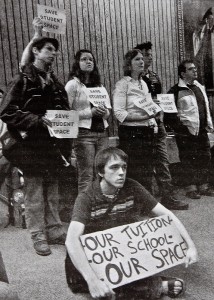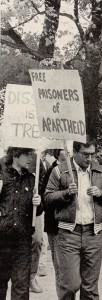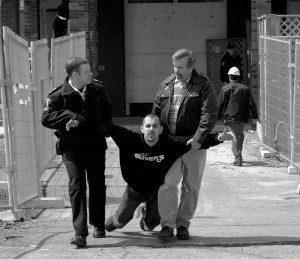When campus safety workers went on strike in March, some students raised a fist in solidarity, some participated in picketing, and some complained about the bus not going onto campus. No matter which category you fell into, you could feel the effects of the strike on campus.
Signs and slogans have appeared on Carleton’s campus many times in the past, and the student body has a long history of protesting where they see injustice, whether that meant sitting in at the president’s office, or chaining themselves to the Ollie’s patio.
Carleton students and communists
Former Carleton history professor David Farr said after the Second World War students became “quite active in their political views.” Farr talked about a 1949 incident as one of the first to spark political activism in the student body.
“There was a communist party in Canada under a man named Tim Buck, who was quite a good orator, and a very strong-willed man who was trying to introduce communism into Canada. The students asked him to come and speak to them, which of course was their right,” Farr said.
“But one of the men on the Board of Governors . . . who had promised quite a nice gift to the college, he decided that he wouldn’t give this gift to a place that had invited the leader of a communist party to come and speak to the students,” he said.
Farr said Carleton students reacted by starting a fundraiser to match the amount of money the member of Carleton’s Board of Governors would withdraw so the school wouldn’t lose any money. However, Farr said Buck eventually withdrew his decision to speak at Carleton because of the controversy it had created.
“That was a political argument that went through Carleton, but the students on the whole were very strong in insisting that they could have anybody they wanted come speak to them, that was their right, and of course that’s what a university stands for,” Farr said.
[timeline src=”https://docs.google.com/spreadsheet/ccc?key=0AurwTSz7Je29dGQ3bTVQSUdvVUF2Nmd1ZjdSaTJ4Y0E&usp=sharing” width=”100%” height=”550″ font=”Bevan-PotanoSans” maptype=”toner” lang=”en” ]Sit-ins in the ‘60s
 According to the Charlatan, (then called the Carleton) archives, one of Carleton’s first major moments of protests was a sit-down demonstration in 1963 over the intersection connecting Bronson to campus.
According to the Charlatan, (then called the Carleton) archives, one of Carleton’s first major moments of protests was a sit-down demonstration in 1963 over the intersection connecting Bronson to campus.
Students wanted to draw attention to the lack of traffic lights. Ottawa’s chief of police referred to the plan as “mob violence.”
The city agreed to implement traffic lights before the day of the protest arrived, showing Carleton students their actions had a legitimate effect on the city. After this event, student protests on and around campus became more frequent.
Farr referred to the 1960s as a time of change for every university. He said protesting often led to students getting violent but the mood at Carleton was usually constructive.
“Carleton was very successful in evading most of the consequences of the student protest . . . our students were not violent like in other universities,” Farr said. “There was very little occupation or destruction compared with things that happened at Queen’s and Toronto or at McGill, where in some cases presidents were forced to resign because they got involved in quarrels on a large scale with the students,” he said. “A lot of this is because of the leadership of (Carleton University President) Davidson Dunton.”
Farr said Dunton was known for diffusing some of the tensest situations in the 1960s that came with the atmosphere of rebellion.
In 1969, in protest of a lack of student representation in Carleton’s university government, students occupied Dunton’s office. The students remained in the office, and made a list of demands to Dunton. He allowed them to stay in his office for the entire day.
“Dunton gave up his office rather than opposing the students that were taking it over, as a symbol of their new authority in the government of the university,” Farr said.
This protest was just one of many surrounding the New University Government. Sit-ins were a common form of protest at this time and students would sit outside Dunton’s office for hours with picket signs, regardless of whether he was inside.
While Farr praised the way Dunton handled the situation, not all students were as charitable. At one point during these protests, the Carleton reported that a student called the police to report a thief hiding inside Dunton’s office—and described him as the president of the university himself. Despite pranks like this, Farr said protests never led to any major incident resulting in the destruction of university property.
 Master’s of history student Martha Bufton said because of Carleton’s proximity to Parliament, much of the protesting that Carleton students participated in during the ‘60s and ‘70s actually occurred off campus.
Master’s of history student Martha Bufton said because of Carleton’s proximity to Parliament, much of the protesting that Carleton students participated in during the ‘60s and ‘70s actually occurred off campus.
“Where in other parts of the country campuses may physically be the location of more protests because they don’t have access to the federal governments. Take women’s rights, by the same token you can march on Parliament Hill and take on [the prime minister] if you want to,” Bufton said.
Students were often drawn to Parliament Hill when protesting against issues such as anti-abortion laws or cuts to student funding, Bufton said.
The embassies scattered throughout Ottawa also proved to be frequent protest sites, and during the war in Vietnam, Carleton students arranged picketing outside the American embassy.
 In the 1970s, Carleton students protested against the lack of government assistance for students at university. In 1977, Ontario Premier Bill Davis cut financial assistance to students. This provoked a backlash from Carleton University Students’ Association (CUSA) president Ben Lachance.
In the 1970s, Carleton students protested against the lack of government assistance for students at university. In 1977, Ontario Premier Bill Davis cut financial assistance to students. This provoked a backlash from Carleton University Students’ Association (CUSA) president Ben Lachance.
CUSA put $1,800 dollars into advertisements denouncing Davis on local radio stations and the Ottawa Citizen. CUSA also organized protests outside the PC Party office. The spending of CUSA funds on political endeavours sparked a harsh reaction from many students, although Lachance justified his actions as a part of the platform he ran on for CUSA president.
In the 1980s, protesting was less common at Carleton, although the apartheid system in South Africa provoked a strong reaction from students. Carleton students participated in demonstrations on both Parliament Hill and outside the South African Embassy, and pushed Carleton’s stores and food services to introduce sanctions on all South African products.
Solidarity on the patio
More recently, social media has enabled student activism. In 2005, when the renovations of the university centre required Oliver’s to become smaller, online forums were central to organizing a protest on the patio on the day of the demolition.
Patti Harper, who works in the university’s archives, referred to the protests outside Oliver’s in 2005 as the “most radical” in recent memory.
“The university was remodeling the Unicentre, part of that process was reducing the footprint of Oliver’s. People were quite upset by that,” Harper said. “The patio became quite infamous. Students were fixing themselves to the patio and trying to block bulldozers and workmen.”
 The demolition of the patio began at 4 a.m., but students met an hour later and occupied the patio. Hours later, hundreds of students were occupying the half-demolished patio, some chained to the fence around it. Many arrests were made in relation to this event.
The demolition of the patio began at 4 a.m., but students met an hour later and occupied the patio. Hours later, hundreds of students were occupying the half-demolished patio, some chained to the fence around it. Many arrests were made in relation to this event.
Eventually the Oliver’s patio was re-constructed, and “the issue resolved itself,” Harper said.
Bufton defined Carleton as a school that protests peacefully, but effectively.
“People always think of Carleton as being quite tame, but that doesn’t mean that people aren’t passionate,” she said. “It means that they aren’t violent.”







